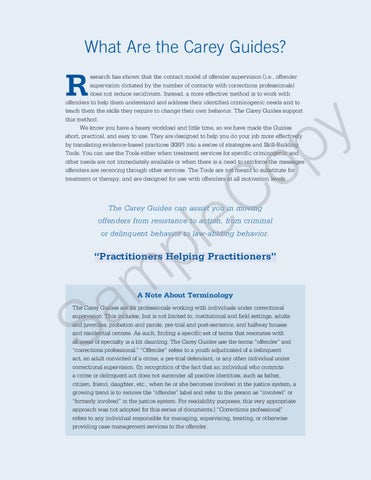What Are the Carey Guides?
R
esearch has shown that the contact model of offender supervision (i.e., offender supervision dictated by the number of contacts with corrections professionals) does not reduce recidivism. Instead, a more effective method is to work with offenders to help them understand and address their identified criminogenic needs and to teach them the skills they require to change their own behavior. The Carey Guides support this method. We know you have a heavy workload and little time, so we have made the Guides short, practical, and easy to use. They are designed to help you do your job more effectively by translating evidence-based practices (EBP) into a series of strategies and Skill-Building Tools. You can use the Tools either when treatment services for specific criminogenic and other needs are not immediately available or when there is a need to reinforce the messages offenders are receiving through other services. The Tools are not meant to substitute for treatment or therapy, and are designed for use with offenders at all motivation levels.
y p o C e l p m a S The Carey Guides can assist you in moving
offenders from resistance to action, from criminal or delinquent behavior to law-abiding behavior.
“Practitioners Helping Practitioners”
A Note About Terminology
The Carey Guides are for professionals working with individuals under correctional supervision. This includes, but is not limited to, institutional and field settings, adults and juveniles, probation and parole, pre-trial and post-sentence, and halfway houses and residential centers. As such, finding a specific set of terms that resonates with all areas of specialty is a bit daunting. The Carey Guides use the terms “offender” and “corrections professional.” “Offender” refers to a youth adjudicated of a delinquent act, an adult convicted of a crime, a pre-trial defendant, or any other individual under correctional supervision. (In recognition of the fact that an individual who commits a crime or delinquent act does not surrender all positive identities, such as father, citizen, friend, daughter, etc., when he or she becomes involved in the justice system, a growing trend is to remove the “offender” label and refer to the person as “involved” or “formerly involved” in the justice system. For readability purposes, this very appropriate approach was not adopted for this series of documents.) “Corrections professional” refers to any individual responsible for managing, supervising, treating, or otherwise providing case management services to the offender.
